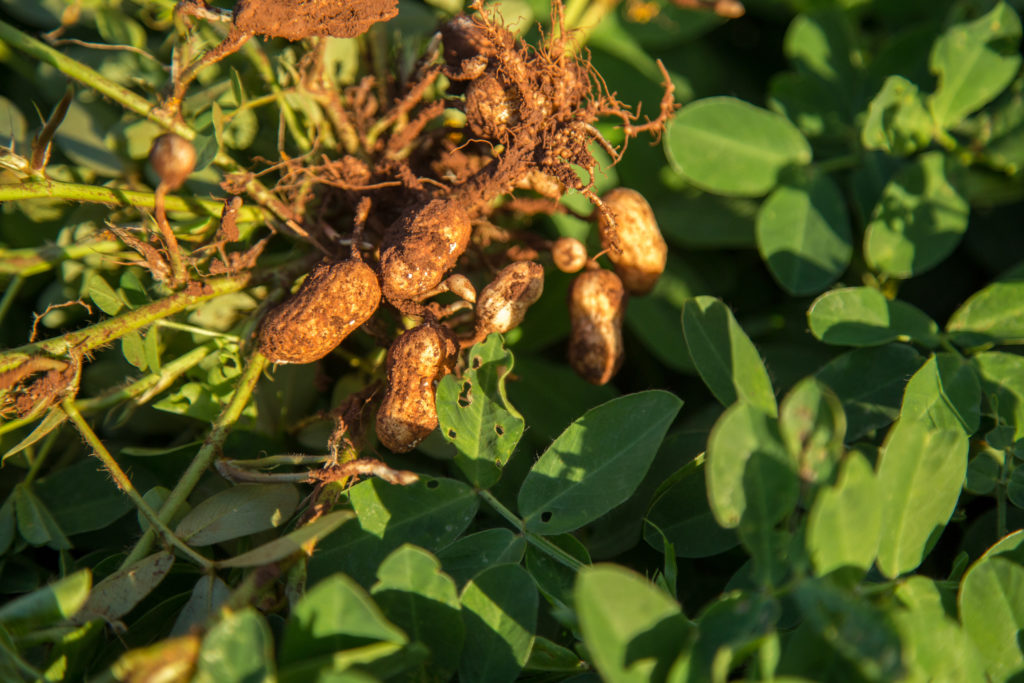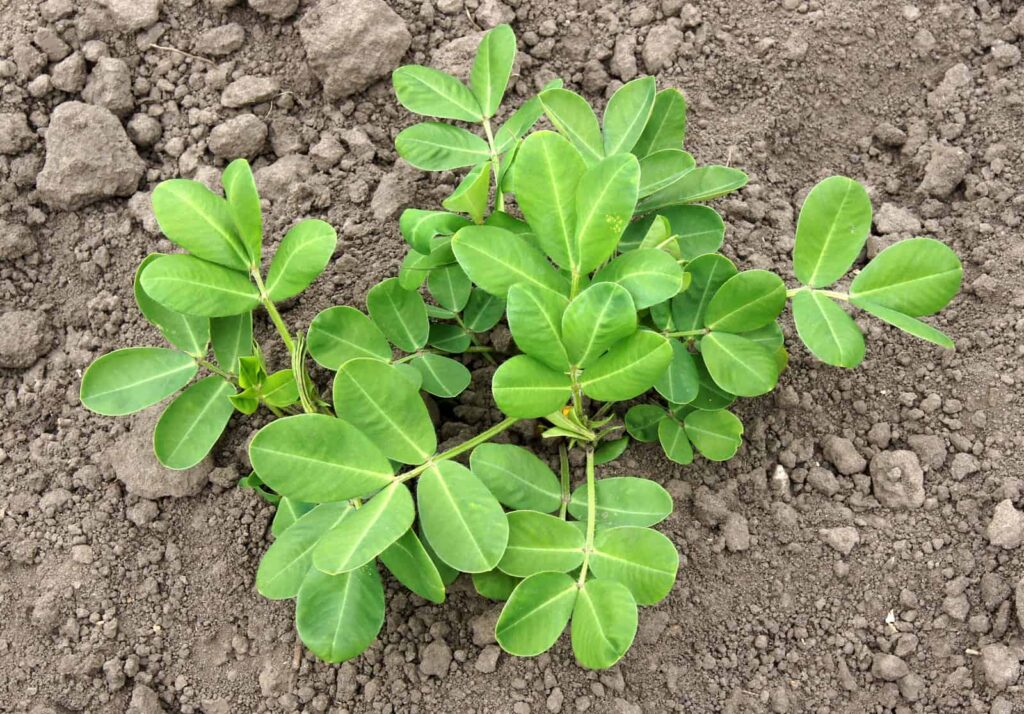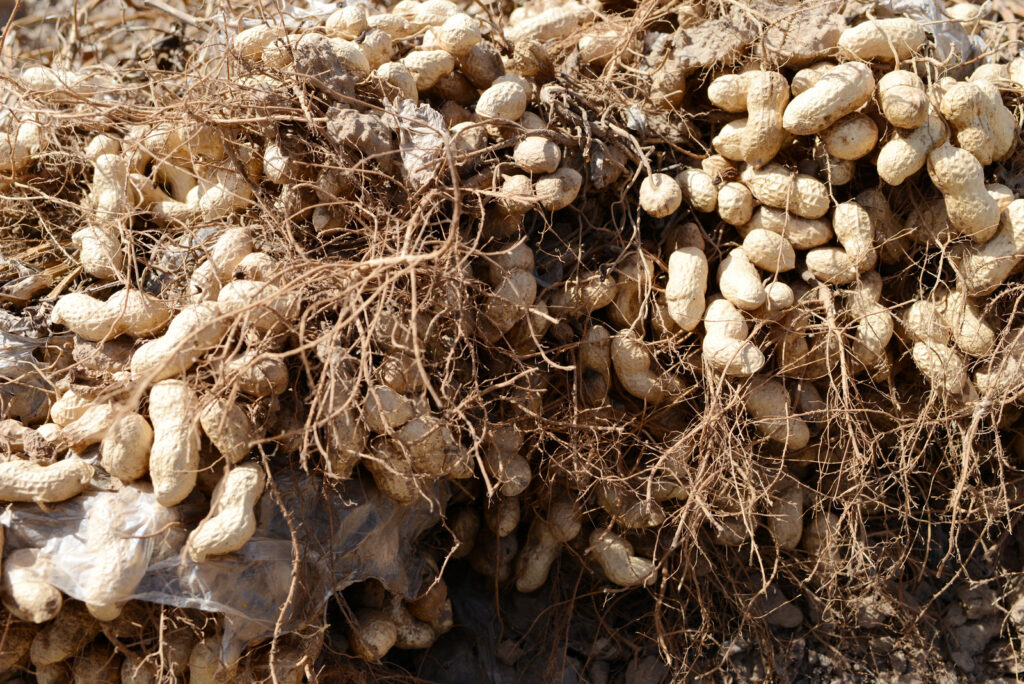Peanuts are easy to grow if you live where there are long, hot summers of at least 4 months (5 is better). The peanut is a warm-weather perennial that is usually grown as an annual. It requires 120 to 130 frost-free days to reach harvest.
The peanut is an odd and interesting plant. It grows 12 to 20 inches tall and bears two kinds of flowers: the first kind is showy, yellow, and also sterile; the second kind is also yellow but fertile and is borne on a recurved stalk that touches the ground, penetrates it, carrying the fertilized ovary beneath the surface where it ripens into what we call a peanut. The peanut’s extraordinary fruiting habit is an interesting curiosity.
Related articles:

Harvesting the peanut is like that of any root crop– the peanut must be dug out when ripe. Usually, the whole plant is lifted with peanuts attached. The fruits are then cured and dried.
There are two general types of peanuts. The one most often grown is the Runner Peanut; it is a vinelike plant that sprawls and requires a considerable amount of room. The other is the Bunch Peanut which grows upright and is bushy. The bunch type is usually grown by those who harvest the tops for forage.
Runner-type peanuts are commonly distinguished by the shape of their nut when shelled. ‘Virginia’ peanuts are long and slender. ‘Runner’ peanuts are small and stubby. ‘Valencia’ peanuts are oval. ‘Spanish’ peanuts are round. Spanish types are the best for northern growing.
Here’s your complete guide to growing peanuts.
Peanut Quick Growing Tips
- Sow peanuts in the garden 3 to 4 weeks after the average last frost date in spring, when the soil has warmed to at least 65°F (18°C).
- To get a head start on the season start peanuts indoors 5 to 8 weeks before transplanting seedlings outdoors.
- Peanuts require a long growing season, about 120 days of warm weather to mature. They can withstand light spring and fall frosts.
- Peanut yield: Grow 10 to 12 peanut plants per household member.
How Peanuts Grow
The peanut plant grows from 12 to 20 inches (15-50 cm) tall, depending on the type; some are upright and erect in form, and others are more spreading or running. Plants form two sets of opposite leaves on each stem and sweet-pea-like yellow flowers at stem ends. There are two kinds of flowers; one is showy and sterile; the second is yellow but fertile. After pollination occurs, stalks on which the faded fertile flowers curve down to penetrate the soil after they have developed long pointed pegs called peduncles. The pegs push 1 to 3 inches into the soil. Below ground, each peg–which is a fertilized ovary–ripens into what is called a peanut.
Types of Peanuts
There are four basic types of peanuts: Runner, Spanish, Virginia, and Valencia.
Runner Peanuts
- Runner-type has uniform medium-sized seeds, usually two seeds per pod, growing from a low bush. Runner types are ready for harvest 130 to 150 days from planting. The uniform sizes of the seed make these a good choice for roasting (often used as beer nuts) and peanut butter. Runner types are grown in Alabama, Florida, Georgia, Oklahoma, and Texas.
Spanish
- Spanish-type has small, roundish seeds covered with reddish-brown skin, growing on a low bush. Spanish-types are ready to harvest 120 days from planting. The Spanish-type peanut has high oil content and is used for oil, peanut butter, and snacks. Spanish-type peanuts are commonly grown in Oklahoma, Texas, and South Africa.
Virginia
- Virginia-type has the largest seed of the four peanut types; the seed is most often roasted. There are commonly two and sometimes three seeds per pod. The Virginia-type peanut stands 24 inches (61cm) tall and spreads to 30 inches (76cm) wide and is ready for harvest 130 to 150 days from harvest. Virginia-type peanuts are mostly grown from southeastern Virginia into northeastern North Carolina.
Valencia
- Valencia-type has three to six small, oval seeds crowded into each pod. Each seed is covered with bright-red skin. Valencia peanuts are often roasted in the shell or boiled fresh and are often used in confections and cocktails. The plants grow to about 50 inches (127cm) tall and spread about 30 inches (76cm); most of the pods are clustered around the base of the plant. The Valencia type is ready for harvest 95 to 100 days from planting. Most Valencia peanuts are grown in New Mexico.
Good Products for Growing Your Garden
- 55 Heirloom Vegetable Varieties–27,500 Non GMO Seeds
- Heirloom Vegetable Seed Collection – 105 Varieties
- Full Spectrum, LED Grow Lights
- Galvanized Raised Garden Bed with Cover
- Gardzen 10-Pack 10 Gallon Grow Bags
- Captain Jack’s Dead Bug Brew
- Harris Neem Oil Plant Disease Control
- Freeze Protection Garden Mesh Netting Kit
- Kitchen Garden Grower’s Guide Vegetable Encyclopedia
- Vegetable Garden Almanac & Planner

Where to Plant Peanuts
- Plant peanuts in full sun.
- Peanuts grow best in loose, well-drained soil rich in organic matter. A sandy-loamy soil is best. The soil must be loose so that the pegs can penetrate and grow.
- Double-dig clay soil and add gypsum and aged compost.
- Work in enough organic matter to make the soil loose and friable. Amend acidic soil by adding sandy loam.
- Peanuts prefer a soil pH of 5.8 to 6.2.
Peanuts Planting Time
- Peanuts require at least 120 frost-free days to reach harvest.
- Sow peanuts in the garden 3 to 4 weeks after the average last frost date in spring, when the soil has warmed to at least 65°F (18°C).
- To get a head start on the season start peanuts indoors 5 to 8 weeks before transplanting seedlings outdoors.
- Peanuts require nearly all of the growing days to have an air temperature greater than 85°F (29°C).
Starting Peanuts in Northern Regions
- Northern gardeners should start peanuts indoors in large peat pots a month before the last frost.
- Sow seed 1 inch deep.
- Place the pot in the sunniest spot possible and water it weekly.
- Transplant seedlings to the garden when the soil temperature warms to between 60° and 70°F.
- Transplant peanuts to sandy loam; sandy loam warms up quickly and will lengthen the peanut growing season.
- A sheltered site that slopes to the south will be the warmest for peanuts growing in northern regions.
- Grow under a floating row cover to hasten growth.
Starting Peanuts in Southern Regions
- Plant peanuts directly in the garden around the date of the last expected frost.
- Space seeds 2 inches deep and 5 inches apart in rows 2 to 3 feet apart.
- Firm the soil and water well.
- Thin peanut seedlings to 10 inches apart.
Planting and Spacing Peanuts
- Sow peanuts in the whole shell or in the papery skin surrounding the seed. If you shell them, don’t remove the thin, pinkish brown seed covering, or the seed won’t germinate.
- Sow seed 1½ to 3 inches (4-7cm) deep; set seed 6 to 8 inches (15-20cm) apart; thin successful plants or set transplants 18 inches (45cm) apart.
- Plant peanuts in double rows to save space, staggering the seeds 18 inches (45cm) apart. Single rows can be spaced 12 to 24 inches (30-61cm) apart.
- When the plants are 12 inches (30cm) tall, mound the soil up around the base of the plant so that faded flowers can set pegs down into the hill.
- For a head start on the season, start peanuts indoors in individual biodegradable peat or paper pots that can be set whole into the garden.
More tips at Peanut Seed Starting Tips.
Hilling Up Peanuts
- When plants are 12 inches tall, hill the soil up around the base of each plant.
- Long, pointed pegs (also called peduncles) grow from faded flowers; the pegs push 1 to 3 inches down into the soil beside the plant.
- Spread a light mulch of straw or grass clippings around each plant so that the pegs will have no difficulty penetrating the soil.
Watering Peanuts
- Peanuts prefer regular, even watering.
- Give peanuts about one inch of water a week (about 6.5 gallons).
- Keep the soil moist until the plants begin to flower, then waterless.
- Once plants are established, allow the soil to dry between waterings.
- Empty pods, sometimes called “blind” pods, are the result of too much rain or humidity at flowering time.
Feeding Peanuts
- Prepare planting beds with aged compost.
- Peanuts, like other legumes, supply their own nitrogen. Avoid nitrogen-rich fertilizers which encourage foliage rather than fruits.
Caring for Peanuts
- Mulch around peanuts to keep the soil surface from crusting and becoming hard; this will allow pegs to penetrate the soil.
- Keep the planting beds weed-free and cultivate lightly to keep the soil loose.
- Mulching around peanuts is effective weed control and will make harvesting easier.

Peanuts Companion Plants
- Grow peanuts with beets and potatoes.
- Do not grow peanuts in the shadow of tall plants such as corn or pole beans.
Container Growing Peanuts
- Peanuts can be grown in containers but allow enough room for flower stems to dip into the soil to set pegs; choose a container at least 18 inches (45cm) across and at least 12 inches (30cm) deep.
Peanut Pests
- Peanuts commonly have no other serious pest problems.
- Fence rodents out of the garden.
- Aphids can be washed away with a steady stream of water.
- Potato leafhoppers sometimes yellow the foliage by feeding; Bordeaux spray will control leafhoppers.
- Corn earworm sometimes feeds on the plant late in the season. Neem oil will control corn earworms.
Peanut Diseases
- Peanuts have no serious disease problems.
- Leaf blights, sclerotium blight, southern root rot, wilt, chlorosis, and fruit rots can occur. These can be controlled by crop rotation with grass or grain cover crops. Destroy infected plants. Plant healthy seeds.

Harvesting Green Stage Peanuts
- Peanuts can be harvested when they are well-formed by not yet fully mature; these are called “green stage” peanuts. The hulls of green stage peanuts are still thin and soft.
- Dig up green stage peanuts and take them off the vine.
- Boil the nuts inside the hulls in salted water.
- After 5 to 10 minutes, remove them from the water, drain, salt, and roast in the oven 10 to 15 minutes. These can be eaten nuts shells and all.
Harvesting Mature Peanuts
- Peanuts will be ready for harvest when the leaves turn yellow and begin to wither, usually 120 to 150 days after planting.
- The inner shells of ripe peanuts will have gold-marked veins; you can check for the gold-marked veins periodically by pulling out a few nuts from the soil and shelling them.
- Dig up the entire plant to get the pods.
- Lift pods with a garden fork, pulling up the whole plant.
- Pulling or digging the plants and roots is easier if the soil is just moist.
- If you wait too long to harvest peanuts, the pegs will become brittle and break off in the ground–making harvesting more difficult.
- Where the growing season is short, the main crop will be under the center of the plant; the peanuts on the outside edge will not have time to finish ripening.
- Shake away loose soil and hang the whole plant to dry for about two weeks in a warm, dry place. When the leaves become crumbly, remove the pods.
- Seeds can be removed when the hulls are completely dry.
- Each plant will yield about 40 to 50 pods or shelled nuts.
- Harvest before the first frost, or after frost when the vines start to turn yellow
Curing Peanuts
- Cure peanuts in the sunshine for a few weeks; bring them indoors if rain is forecast.
- In cold climates or wet weather, hang peanut plants to cure in an airy but shaded place, a garden shed or attic.
- Peanuts should cure for about 2 months.
- When the leaves are dry and crumbly, take the nuts off the vines, roast them, and store them.
- If peanuts are not dry, place them in a mesh bag or cardboard box to dry another 2 or w weeks.
- If peanuts become moldy, place them in the trash. Peanut mod is a dangerous carcinogen.
Storing and Preserving Peanuts
- Raw, unshelled peanuts can be kept in a dry, dark, well-ventilated place for up to 3 months.
- Dried-shelled peanuts can be stored in a cool, dry place for 10 to 12 months.
- Shelled peanuts can be sprouted, frozen, used for peanut butter, or roasted for snacks.
- 1shelled peanuts can be stored briefly in airtight containers and refrigerated.
- For long storage, peanuts can be frozen.
Roasting Peanuts
- To roast peanuts, spread them out in a shallow pan or on a cookie sheet and roast at 350°F. Stir frequently. Roast for about 15 to 20 minutes.
- To know if a roasted peanut is done, remove shells at intervals to check.
- When the skin slips off easily and the nut is light brown and tastes “roasted”, it is done.
- A properly roasted peanut will have a brittle shell and an inner skin that comes off easily.
Peanut Varieties to Grow
- Runner (130-150 days): ‘Florunner’; ‘Southern Runner’.
- Spanish (120 days): ‘Early Spanish’; ‘Pronto’; ‘Star Spanish’.
- Virginia (130-150 days): ‘Carwile’s Virginia’; ‘Jumbo’.
- Valencia (95-120 days); ‘Georgia Red’; ‘Tennessee Red’; ‘Valencia A’.
About Peanuts
- Common name. Peanut, goober, groundnut
- Botanical name. Arachis hypogaea
- Family: Legume
- Origin. Brazil, South America
Garden Planning Books at Amazon:
- Vegetable Garden Almanac & Planner
- Kitchen Garden Grower’s Guide Vegetable Encyclopedia
- Vegetable Garden Grower’s Guide
- Tomato Grower’s Answer Book
More how to grow articles:
Learn how to plant, grow, and harvest your favorite vegetables. Click below for all you need to know.
- Artichoke
- Arugula
- Asparagus
- Beans, Snap
- Beets
- Broad Beans
- Broccoli
- Brussels Sprouts
- Cabbage
- Cantaloupe — Melons
- Cardoon
- Carrots
- Cauliflower
- Celeriac
- Celery
- Chard
- Chayote Squash
- Chickpeas
- Chicory
- Chinese Cabbage
- Collards
- Corn Salad
- Corn, Sweet
- Cresses
- Cucumbers
- Eggplant
- Endive and Escarole
- Fava Beans
- Florence Fennel
- Garbanzo Beans
- Garlic
- Horseradish
- Jerusalem Artichoke
- Kale
- Kohlrabi
- Leeks
- Lettuce
- Lima Beans
- Melons
- Mizuna
- Mustard Greens
- New Zealand Spinach
- Okra
- Onions
- Parsnips
- Peanuts
- Peas
- Peppers
- Potatoes
- Pumpkins
- Radicchio
- Radishes
- Rhubarb
- Rutabaga
- Salsify
- Shallots
- Sorrel
- Southern Peas
- Soybeans
- Spinach
- Squash, Summer
- Squash, Winter
- Sunchokes
- Sweet Potato
- Swiss Chard
- Taro
- Tomatillo
- Tomatoes
- Turnips
- Watermelon
- Zucchini


















